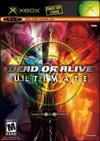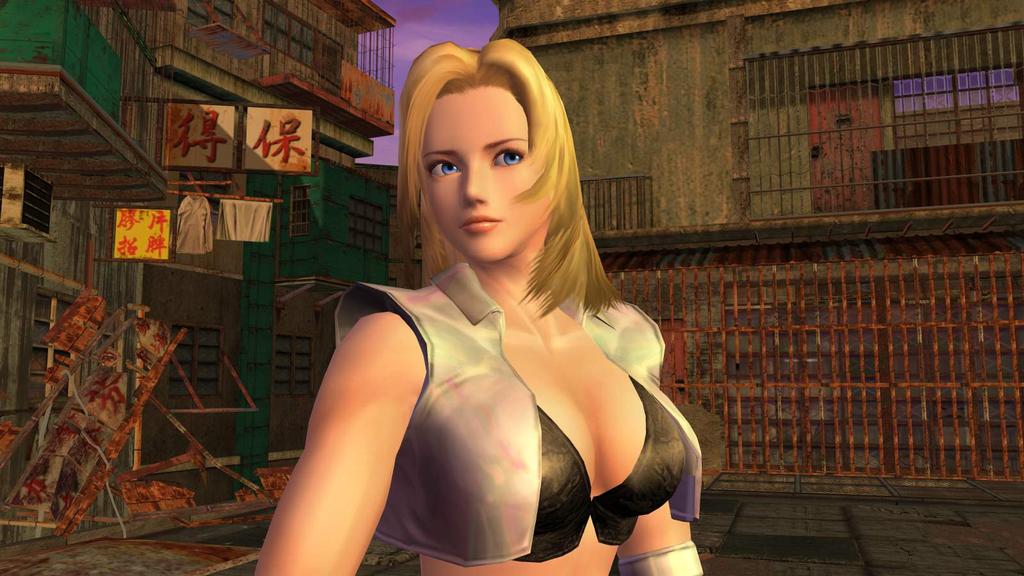


 Though Dead or Alive is nearly 10 years
old, the 3D fighting game series has never quite managed to
steal the limelight from its direct competitors, namely
Virtua Fighter, Tekken, and Soul Calibur. That is...not until
now. Dead or Alive Ultimate features the series' signature
characters and gameplay, which strikes a good balance between
offering flashy pick-up-and-play appeal and delivering the
long-term depth that fighting game fans want. Furthermore, it
sports the most fully featured online multiplayer mode of any
fighting game yet, which is a huge accomplishment. This
multiplayer mode presents some innovative twists that
admirably attempt to restore the spirit of arcade
competition, where the fighting game genre was born and
thrived. With that said, the core gameplay in Dead or Alive
Ultimate really hasn't changed much since the release of Dead
or Alive 2 about five years ago, so if you've played any of
the recent installments in the series, you'll know exactly
what to expect here. But thanks to a beautiful new coat of
paint--not to mention the online play--the series'
time-tested formula seems better than ever now.
Though Dead or Alive is nearly 10 years
old, the 3D fighting game series has never quite managed to
steal the limelight from its direct competitors, namely
Virtua Fighter, Tekken, and Soul Calibur. That is...not until
now. Dead or Alive Ultimate features the series' signature
characters and gameplay, which strikes a good balance between
offering flashy pick-up-and-play appeal and delivering the
long-term depth that fighting game fans want. Furthermore, it
sports the most fully featured online multiplayer mode of any
fighting game yet, which is a huge accomplishment. This
multiplayer mode presents some innovative twists that
admirably attempt to restore the spirit of arcade
competition, where the fighting game genre was born and
thrived. With that said, the core gameplay in Dead or Alive
Ultimate really hasn't changed much since the release of Dead
or Alive 2 about five years ago, so if you've played any of
the recent installments in the series, you'll know exactly
what to expect here. But thanks to a beautiful new coat of
paint--not to mention the online play--the series'
time-tested formula seems better than ever now.
Dead or Alive Ultimate actually consists of two different 3D fighting games: "Ultimate" versions of the original Dead or Alive and its vastly superior sequel, which made quite a splash on the Dreamcast and the PlayStation 2 in 2000. Both games offer similar online play features but otherwise basically stay true to their roots. The package's "Ultimate" version of Dead or Alive 2 is the obvious highlight, featuring vastly improved visuals over its previous incarnations and much more sophisticated gameplay than the first Dead or Alive game. Collectively, these things make the older Dead or Alive title (which is inexplicably included on a separate disc) look merely like some kind of throwaway extra. It's a relatively ugly, simplistic game, but if you're nostalgic for Dead or Alive, you'll appreciate its inclusion. The Xbox's own Dead or Alive 3 is noticeably absent from DOAU, but it's really no loss--Hitomi, the most popular of that game's three additional characters, is unlockable in DOA2 Ultimate, and DOA3 didn't do much more than include these few extra characters and spruced-up graphics.
 Dead or Alive has always had two specific
features that distinguished the series: One is the
fantastical proportions of the game's female characters, and
two is every single character's ability to reverse just about
any punch or kick your opponent can muster. These features
are fully intact in DOAU, especially in the better of the two
games. Reversals add an additional dimension of
rock-paper-scissors-style balancing to the proceedings. It
works like this: Characters can execute high-, mid-, and
low-hitting attacks, which must be blocked high or low--or,
better yet, reversed. A reversal deals damage proportional to
the strength of the attack on the receiving end, so those who
predictably rely on the same strong punches or kicks over and
over are basically just asking for a major beating. Missed
reversals leave you open to counterattack, of course, and
getting thrown while attempting a reversal causes you to take
more damage than usual. On the other hand, throw attempts are
easily disrupted by punches or kicks. None of this is quite
as complicated as it sounds, however. Basically, the idea is
to remain unpredictable by mixing up your offense and
defense.
Dead or Alive has always had two specific
features that distinguished the series: One is the
fantastical proportions of the game's female characters, and
two is every single character's ability to reverse just about
any punch or kick your opponent can muster. These features
are fully intact in DOAU, especially in the better of the two
games. Reversals add an additional dimension of
rock-paper-scissors-style balancing to the proceedings. It
works like this: Characters can execute high-, mid-, and
low-hitting attacks, which must be blocked high or low--or,
better yet, reversed. A reversal deals damage proportional to
the strength of the attack on the receiving end, so those who
predictably rely on the same strong punches or kicks over and
over are basically just asking for a major beating. Missed
reversals leave you open to counterattack, of course, and
getting thrown while attempting a reversal causes you to take
more damage than usual. On the other hand, throw attempts are
easily disrupted by punches or kicks. None of this is quite
as complicated as it sounds, however. Basically, the idea is
to remain unpredictable by mixing up your offense and
defense.
You won't find much of an opponent in the game's artificial intelligence, unfortunately. The AI does make for a respectable challenge in the short run, and playing against it is the key to unlocking much of the game's ample supply of unlockable costumes and other extras. However, the AI is rather predictable despite being fairly tough at higher difficulty levels, at which it'll mostly just reverse your moves with greater frequency. So, blazing through the story mode is really a cinch, at which time you might miss your character's ending if you so much as blink. The story mode really hasn't changed at all after all these years, and though it lets you quickly practice against a bunch of the game's characters (matches are only one round in story mode), it's just not that great. Fortunately, there are numerous other gameplay modes available, including a fast-paced survival mode in which additional challengers keep jumping into the arena one after another, as well as tag battles in which you can quickly switch between a pair of characters who can sometimes band together for some superpowered combos and special throws. Of course, there's an offline versus mode, too. However, online is where Dead or Alive Ultimate has the most potential--and tons of it.
 In addition to the standard Xbox Live quick
match and optimatch options, the game gives you a lot more
flexibility when creating (or searching for) a match than you
might expect. The main innovation here is a lobby system that
allows up to eight players to congregate in a single "virtual
arcade." Imagine this online chat room as a metaphor for up
to eight friends and/or strangers hanging around an arcade
cabinet in the '90s. Basically, two players still duke it out
one match at a time, although everyone else can observe the
match, mess with the camera perspective while waiting for his
or her turn, and discuss the finer points of the fight (via
voice chat) as it wears on. The voice communication is never
interrupted as matches begin and end, nor is there really any
noticeable loading time at any point in the game
(even, say, if players pick four different characters in a
tag team match), so the social dynamic of DOAU's lobby system
seems to be very well integrated. It begs the question,
though, of why you'd deliberately want to wait to play
between matches. The answer is that, in general, you probably
wouldn't want to do so. So if you prefer a traditionally
"home-style," uninterrupted one-on-one fighting-game
experience, DOAU lets you set one up by limiting your player
lobby to two players when creating a match. The two of you
can then keep playing as much as you'd like.
In addition to the standard Xbox Live quick
match and optimatch options, the game gives you a lot more
flexibility when creating (or searching for) a match than you
might expect. The main innovation here is a lobby system that
allows up to eight players to congregate in a single "virtual
arcade." Imagine this online chat room as a metaphor for up
to eight friends and/or strangers hanging around an arcade
cabinet in the '90s. Basically, two players still duke it out
one match at a time, although everyone else can observe the
match, mess with the camera perspective while waiting for his
or her turn, and discuss the finer points of the fight (via
voice chat) as it wears on. The voice communication is never
interrupted as matches begin and end, nor is there really any
noticeable loading time at any point in the game
(even, say, if players pick four different characters in a
tag team match), so the social dynamic of DOAU's lobby system
seems to be very well integrated. It begs the question,
though, of why you'd deliberately want to wait to play
between matches. The answer is that, in general, you probably
wouldn't want to do so. So if you prefer a traditionally
"home-style," uninterrupted one-on-one fighting-game
experience, DOAU lets you set one up by limiting your player
lobby to two players when creating a match. The two of you
can then keep playing as much as you'd like.
Dead or Alive: Ultimate truly is the best, most fully featured title in the Dead or Alive series yet. In addition, it's a landmark achievement in the fighting game genre's history-in-the-making, thanks mostly to DOAU's impressive online play component and thanks partly to the game's incomparably good visuals. The fact that the Dead or Alive gameplay formula holds up this well after all these years also speaks volumes, because those who might have mistaken the game's slight learning curve for a lack of complexity in the past will surely see things differently this time...from the moment they happily first get trounced online.
